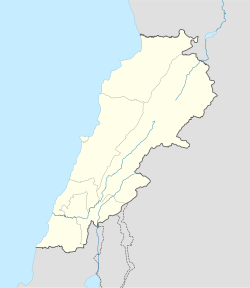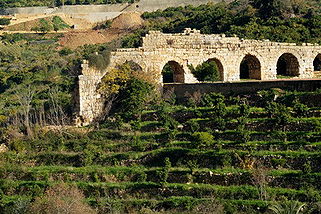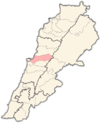- Mansourieh
-
Mansourieh
المنصورية— City — Location within Lebanon Coordinates: 33°51′29″N 35°34′7″E / 33.85806°N 35.56861°ECoordinates: 33°51′29″N 35°34′7″E / 33.85806°N 35.56861°E Country  Lebanon
LebanonGovernorate Mount Lebanon Governorate District Matn District Government – Time Zone GMT +2 (UTC) – - Summer (DST) +3 (UTC) – Area Code(s) (+961) 4 – Zip Code 22411 Area – Total 2.83 km2 (1.1 sq mi) Highest elevation 350 m (1,148 ft) Lowest elevation 200 m (656 ft) Time zone EET (UTC+2) – Summer (DST) EEST (UTC+3) Postal code Dialing code +961 Mansourieh, (Arabic: المنصورية translit. al-Manṣūriyat) (also el-Mansourieh, Mansouriyeh, Mansouriyet el-Matn) is a village in the Matn District of the Mount Lebanon Governorate, Lebanon.
Contents
Overview
About 10 km east of Beirut, on a hilltop overseeing the capital, lies Mansourieh the gateway to Northern Matn.
Etymology
The name originates from the Arabic: منصور (translit. Manṣūr) meaning victorious, presumably dating back to a battle between the Crusaders and the Arabs in which the latter emerged victorious.
Geography
Mansourieh consists of the village, seated on top of a ridge, bordered to the south and southwest by a river, the Beirut River and to the north by the Mar Roukouz (St. Roches) ravine. Upwards to the east Mansourieh merges with Ain Saadeh and Monte Verde, and slopes downhill westwards to Mkalles and Sin el-Fil. Across the river to the southwest lies the Hazmieh town, part of the Baabda district. Daychounieh covers the southeastern side, facing Baabda and Louaize [1].
Mansourieh is 16 km to the Capital (Beirut), 16 km to the Province Administrative Center (Baabda) and 12 km to the Caza Administrative Center (Jdeideh). Mansourieh slopes upwards from an elevation of approx. 200m to reach its highest at around 350m.
Until the early nineties of the last century, Mansourieh was mostly a rural area. Plains along the banks of the Beirut River were cultivated with citrus orchards. Olive groves were traditionally grown in more arid areas. Pine forests covered the southeastern slopes. Vineyards and fig trees, along with other Mediterranean cultivars, completed the landscape.
Due to intensive urbanization since the second half of the last century, lots of green areas have been replaced by residential and commercial buildings. Few green areas remain, mainly along the river bank.
Mansourieh lies on the main road running from Beirut through Sin el-Fil and Mkalles, winding up the mountain to reach Baabdat, Bikfaya and Upper Matn. The 'Ras el-Matn' road connects Northern Matn to Southern Matn villages, starting from Monte Verde.
Beirut River flows east to west from Lebanon’s mountains passing south of Mansourieh to the Mediterranean Sea. The River is crossed by a dam locally called 'Jisr es-Sid' (Bridge of the Dam) built during the French mandate. With the dam, part of the river water is diverted to irrigate the Hadath and Kfarshima coastal planes. A bridge on top of the dam links Mansourieh to Hazmieh's Mar Takla and Mar Roukouz neighborhoods.
Mansourieh municipality administers the industrialized Mkalles zone and the Daychounieh village.
Demographics
As of 2009, Mansourieh houses a population of approx. 17,000 of whom 1,445 are voters and 2,254 native residents. Residences number approximately 4,500 [2].
Education
Mansourieh is home to the following educational institutions:
- Public Intermediate School for Boys & Girls
- Maximus Fifth School
- Arab Baptist Theological Seminary [1]
- Lebanese University, Literature [2]
In addition to the institutions found within village limit, several others are located a few kilometers around:
- Saint Martinos School (Monte Verde)
- Université Saint Joseph [6] (Mar Roukouz)
- Sagesse High School, Mary Mother of Wisdom [7] (Ain Saadeh)
- Collège des Frères Mont La Salle [8] (Ain Saadeh)
- Collège de la Sainte Famille [9] (Fanar)
- Lebanese University, Human Sciences [10] (Fanar)
- Lebanese University, Engineering [12] (Roumieh)
Medical Institutions
- Hospital Beit Al Ajouz (Mansourieh)
- Bellevue Medical Center [13] (Mansourieh)
Archaeological Sites
Located in the secluded river valley between Mansourieh and Hazmieh are the remains of a little known Roman aqueduct.
During the Roman period, with the expanding urbanization of Beirut, the demand for running water outgrew the capacity of the existing wells and springs. The solution was to get water from one of the springs located along the Beirut River. The nearest spring was the Daychounieh source, situated 20 km southeast of Beirut. The Roman architects built a water channel to convey this water across the Beirut River and transport it onwards to Beirut.
It was built over an arched, bridge-like structure known today as 'Qanater es-Sett Zubaida' (The Arches of Mistress Zubaida) [3]. The aqueduct consisted of a series of arches of which only a small number remains on the sides of the river [4]. It was built in 273 AD, during the reign of Roman emperor Aurelian and was also used as a way station for the Roman military in Lebanon [5]. The name Zubaida can be identified with the famous al-Zabba'/Bat-Zabbai/Zenobia of Palmyra, who may have built it. It can also be associated with Princess Zubaida, wife of caliph Haroun ar-Rashid. Curiously, another Roman aqueduct on the Nahr Ibrahim (Adonis river) bears the same name.
Religion
Mansourieh native inhabitants are Christians predominantly Greek Orthodox. Population influx in the last 20 years diversified the religious panorama to include Maronites and other Christian and Muslim denominations.
Churches
- Mar Elias (Saint Elijah Church) – Greek Orthodox (Mansourieh)
- Miled Es-Saydeh [14] (Saint Mary Church) – Greek Orthodox (Mansourieh)
- Mar Gergis (Saint George Church) – Maronite (Daychounieh)
- St. Thérèse [15] (Sainte Thérèse Church) – Maronite (Ain Saadeh)
- Mar Elias (Saint Elijah Church) – Greek Orthodox (Mkalles)
- Mar Elias (Saint Elijah Church) – Maronite (Mkalles)
Families
- Hajj (Abdo, Hajj, Issa, Khattar, Khoury, Wakim, Zeidan)
- Hamouch (Abi Khalil, Abi Nassif, Abi Rached, Hamouch, Merhej, Sakr)
- Murr
Hajj Family
The Hajj family history traces back to the 17th century when its ancestor Hanna el-Hajj fled his hometown Beit Mellat, a village in Akkar in the North. He finally settled near the river at the southern edge of modern day Mansourieh.
Stories have it that Hanna 'Hawwa' el-Hajj, was son to a family of seven brothers and a sister named Hawwa (Arabic for Eve), hence the surname. The whole family, Christian by denomination, worked at a flour mill owned by a Muslim Emir. A dispute broke out between the Hajj family and the Emir, which led to the Emir’s murder and the banishment of the Hajj family. Some of the family members escaped to Jbeil and later moved to other villages.
Little is known of Hanna, but his journey and dwellings in different places (Jbeil, Antelias, Achrafieh, Chiyah), proves him an expedient man willing to fight for his rights and possessions. Quarrels with local inhabitants forced him to change places, finally settling in the Zireh-Daychounieh area south of Mansourieh.
At the time, the land belonged to Druze families, mainly the Badghan clan. They hired labor to cultivate and care for their livestock. Hanna worked for those families in exchange for land. In Zireh Hanna built a small church, erect to this day although disused, known as Mar Gergis (Saint George), where he was eventually buried. Hanna had two sons Youssef and Moussa.
In those days, the entire area was under control of the Abi Lamaa feudal Emirs. Stories tell of a day when, on their way to Mtein village, some of the Emir men were caught in severe weather, forcing them to spend the night at Hanna's. Overwhelmed by their host's generosity they related the episode to the Emir who, somewhat envious, decided to get rid of Hanna and dispatched his troops to that effect. Hanna, sensing trouble, greeted them with the same hospitality, leading to a reconciliation with the Emir.
Youssef and Moussa inherited their father’s competence, generosity and cunning, strengthening the relation with the Emir. The Emir summoned the two brothers and asked them to work his land instead. They accepted and moved to uptown Mansourieh, closer to the Emir whereabouts. Married, they lived in what is known to this day as the 'Harah' in the heart of the village.
Hamouch Family
Stories have it that the 16th century family of Hamouch originated in a small village named Mizlla near Maad in Jbeil. The father, a righteous man, was known to protect Christians from persecutions. His antagonists retaliated against the children after their father’s demise. As a result the family of four children, Trad, Hamouch, Malek and Melki scattered to different locations around Lebanon.
The family first moved to Ain el-Qabou near Baskinta, Trad spent winters in Beirut, Hamouch in Mansourieh where he eventually settled. Malek later moved to Baabdat and Melki to the North.
In subsequent generations the Hajj family acquired the lands in the middle and lower parts of Mansourieh, Hamouch family dwelt in the upper parts of the village.
References and Footnotes
- ^ "Wikimapia, Mansourieh". http://wikimapia.org/846774/Mansourieh. Retrieved June 26, 2009.
- ^ "Mansouriyet El Matn E-Community". http://www.baldati.com/networks/community.php?networkid=1004. Retrieved June 23, 2009.
- ^ Locally 'Zbaydeh'
- ^ "Destination Lebanon, Aqueduct of Zubaida". http://www.destinationlebanon.com/SiteSeeing/Historical/Deir_el_Qualaa.aspx. Retrieved June 24, 2009.
- ^ "Roman Aqueducts Reference List, Lebanon". http://www.romanaqueducts.info/aqualib/aqualit.htm#lebanon. Retrieved June 24, 2009.
External links
 Matn District, Mount Lebanon GovernorateCapital: Jdeideh
Matn District, Mount Lebanon GovernorateCapital: JdeidehTowns and villages Ain Aar · Ain el Safssaf · Ain el Sendianeh · Ain Saadeh · Aintoura · Amaret Chalhoub · Antelias · Aoukar · Ayroun · Baabdat · Baskinta · Bauchrieh · Beit Chabab · Beit el Chaar · Beit el Kekko · Beit Mery · Bhersaf · Biakout · Bikfaya · Bkenneya · Bourj Hammoud · Broummana · Bsalim · Bteghrine · Chaouiyeh · Choueir · Daher al Hosein · Dahr el Sawan · Daychounieh · Dbayeh · Dekwaneh · Dik El Mehdi · Dhour El Choueir · Dora · Douar · Fanar · Ghabeh · Ghabet Bologna · Hadirah · Haret al Ballaneh · Hbous · Jal el Dib · Jdeideh · Jouar · Kaakour · Kfarakab · Kfartay · Khenchara · Majdel Tarchich · Majzoub · Mansourieh · Mar Chaaya · Mar Michael Bnabil · Mar Moussa · Mar Roukouz · Marjaba · Mazraat Yachouh · Mchikha · Mezher · Mhaydseh · Mkalles · Mrouj · Mtaileb · Mtein · Mzekkeh · Nabay · Naccache · Ouyoun · Qonaytrah · Qonnabat Broummana · Qornet Shehwan · Rabieh · Roumieh · Sakiyat al Mesek · Sed el Bauchrieh · Sin el Fil · Wata el Mrouj · Zalka · Zarooun · Zekrite · Zouk al KhrabNotable landmarks Notable touristic sites Aqueduct of Zubaida · Deir el Qalaa Archaeological sites in LebanonAadloun • Aaiha • Aammiq • Ain Harcha • Akbiyeh • Amioun • Anjar, Lebanon • Antelias cave • Ard Tlaili • Arqa • Baalbek • Batroumine • Batroun • Beirut • Beit Mery • Byblos • Dahr El Ahmar • Dakoue • Deir El Aachayer • Deir el Ahmar • Dekwaneh • Douris (Baalbek) • Elaea (Lebanon) • Hadeth south • Haret ech Cheikh • Hashbai • Hermel plains • Iaat • Jabal es Saaïdé • Jbaa • Jdeideh • Jebel Aabeby • Jeita Grotto • Joub Jannine • Jieh • Kamid al lawz • Kaukaba • Kefraya • Kfar Qouq • Kfarhata • Ksar Akil • Labweh • Lake Qaraoun (Ain Jaouze) • Lion Tower • Majdal Anjar • Mansourieh • Maronite mummies • Mayrouba • Moukhtara · Mtaileb · Nabi Zair • Nachcharini • Neba'a Faour • Niha Bekaa • Qaraoun • Ras Baalbek I • Ras Beirut • Ras El Kelb • Sands of Beirut • Sidon • Sin el Fil • Sarepta • Stone of the Pregnant Woman • Tahun ben Aissa • Tell Ain Nfaikh • Tell Ain Saouda • Tell Deir • Tell el-Burak • Tell Khardane • Tell Jisr • Tell Mureibit • Tell Neba'a Litani • Tell Zenoub • Tell Zeitoun • Temple of Bacchus • Temple of Eshmun • Toron • Tripolis (region of Phoenicia) • Tyre Necropolis • Tyre, Lebanon • Yanta • Ain W Zain • Zahlé •Categories:
Archaeological sites in LebanonAadloun • Aaiha • Aammiq • Ain Harcha • Akbiyeh • Amioun • Anjar, Lebanon • Antelias cave • Ard Tlaili • Arqa • Baalbek • Batroumine • Batroun • Beirut • Beit Mery • Byblos • Dahr El Ahmar • Dakoue • Deir El Aachayer • Deir el Ahmar • Dekwaneh • Douris (Baalbek) • Elaea (Lebanon) • Hadeth south • Haret ech Cheikh • Hashbai • Hermel plains • Iaat • Jabal es Saaïdé • Jbaa • Jdeideh • Jebel Aabeby • Jeita Grotto • Joub Jannine • Jieh • Kamid al lawz • Kaukaba • Kefraya • Kfar Qouq • Kfarhata • Ksar Akil • Labweh • Lake Qaraoun (Ain Jaouze) • Lion Tower • Majdal Anjar • Mansourieh • Maronite mummies • Mayrouba • Moukhtara · Mtaileb · Nabi Zair • Nachcharini • Neba'a Faour • Niha Bekaa • Qaraoun • Ras Baalbek I • Ras Beirut • Ras El Kelb • Sands of Beirut • Sidon • Sin el Fil • Sarepta • Stone of the Pregnant Woman • Tahun ben Aissa • Tell Ain Nfaikh • Tell Ain Saouda • Tell Deir • Tell el-Burak • Tell Khardane • Tell Jisr • Tell Mureibit • Tell Neba'a Litani • Tell Zenoub • Tell Zeitoun • Temple of Bacchus • Temple of Eshmun • Toron • Tripolis (region of Phoenicia) • Tyre Necropolis • Tyre, Lebanon • Yanta • Ain W Zain • Zahlé •Categories:- Populated places in the Mount Lebanon Governorate
- Matn District
- Archaeological sites in Lebanon
- Roman sites in Lebanon
- Roman aqueducts
Wikimedia Foundation. 2010.




